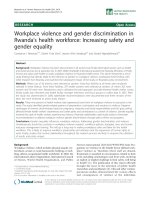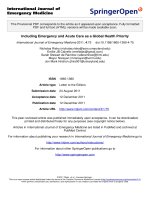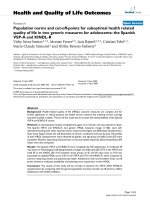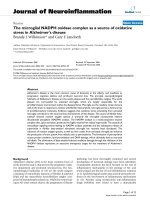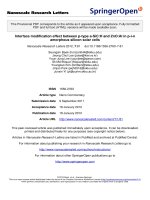Báo cáo toán học: " Including emergency and acute care as a global health priority" potx
Bạn đang xem bản rút gọn của tài liệu. Xem và tải ngay bản đầy đủ của tài liệu tại đây (145.84 KB, 2 trang )
LET T E R TO THE EDITOR Open Access
Including emergency and acute care as a global
health priority
Nicholas Risko
1*
, Emilie JB Calvello
2
, Sarah Stewart de Ramirez
3
, Mayur Narayan
4
and Jon Mark Hirshon
5
Abstract
A recent important global meeting to set the international action agenda concerning non-communicable diseases
(NCDs) failed to draw substantial attention from the emergency medical and surgical community. Advocacy efforts
on the part of emergency clinicians should be increased to highlight the critical services we provide and create an
approach to addressing NCDs with the most effective balance of preventive and acute care services. Acute care,
which encompasses all frontline treatment services for sudden or unexpecte d injury or illness, can serve as a focal
point for the development of the common language and body of research needed to draw the attention of global
leaders and policy makers.
Letter to the Editors
Recently, the United Nations (UN) General Assembly
met in New York to discuss a topic of critical impor-
tanc e, the prevention and control of non-communicable
diseases (NCDs). This meeting provided an important
update to the 2000 World Health Assembly, which pre-
sented a global strategy to combat NCDs, resting upon
the pillars of surveillance, primary prevention, a nd
strengthened health care. Unfortunately, over the past
decade limited advocacy from health-delivery fields has
led to an agenda that emphasizes prevention while giv-
ing inadequate attention to strengthening health care.
Though prevention is essential, acute care specialties
that provide frontline treatment for s udden or unex-
pected illness or injury, like emergency medicine, need
to take immediate and sustained action to highlight t he
importance of the services they provide. Aligning key
players to support developing countries in planning for
the best mix of acute and preventive services is an
urgent priority with the potential to save and improve
millions of lives.
We have many compelling reasons to get involved.
The UN reports that 36 million people died from NCDs
in 2008, representing 63% of the 57 million global
deaths that occurred during that year. Eighty percent of
the NCD deaths were caused by four conditions:
cardiovascular diseases, diabetes, cancers, and chronic
respiratory diseases. An increasing proportion of these
deaths are occurring in developing countries as they
move through the epidemiologic transition. UN projec-
tions show that by 2030, non-communicable diseases
will cause five times as many deaths as communicable
diseases worldwide [1,2].
Steps by the global community to combat NCDs have
not adequately addressed the need to strengthen our
ability to provide acute care. The WHO Framework
Convention on Tobacco Control [3], the Global Strategy
on Diet, Physical Activity and Health [4], the Global
Strategy to Reduce the Harmfu l Use of Alcohol [5], and
the 2008-2013 Action Plan for the Global Strategy for
the Prevention and Control of Non-Communicable Dis-
eases [6] are all evidence of this. The recent General
Assembly presented a valuable opportunity for global
decision makers to correct this oversight; however, it
appears that acute care was once again crowded off the
agenda.
The recently released UN Report of the Secretary-
General on the preventio n and control of NCDs [1]
aggressively attacked acute care platforms that provide
essential and life-saving care to million s. Remarkably, in
sections devoted to strengthening health-system capacity
and response, the report states: “Health-care services
models should be transformed from acute emergency
care to chronic lifelong care” (p 13). This presents a
troubling lack of understanding on the part of global
leaders about the importance of access to high-quality
* Correspondence:
1
University of Maryland School of Medicine, 655 W. Baltimore Street,
Baltimore MD 21201, USA
Full list of author information is available at the end of the article
Risko et al. International Journal of Emergency Medicine 2011, 4:75
/>© 2011 Risko et al; licensee Springer. This is an Open Access a rticle distributed u nder the terms of the Creative Commons Attribution
License ( icenses/by/2.0), which permits unrestricted use, distribution, and repr oduction in any medium,
provided the original work is properl y cited.
acute care. These two elements should not be viewed as
mutually exclusive. In developing country settings, it is
critical that we focus on the full spectrum of care, from
prevention to acute treatment to chronic life care and
rehabilitation, if we are to relieve suffering and save
lives.
Our message should emphasize how acute care plays a
crucial function i n the simple prevention of death and
disability that primary care is not positioned to provide.
Additionally, it is critical that global leaders recognize
that even with full preventive measures the need for
access to high-quality acute c are will remain. The four
NCDs outlined as priorities by the WHO all contain
presentations that require the life-saving tools and
knowledge only available through emergency care ser-
vices. In the United Kingdom, despite relatively easy
access to primary and preventive care, statistics show a
rate of 29 visits/100 people per year to Accident and
Emergency Departments across the c ountry, with a siz-
able number of these visits due to complicatio ns of
NCDs [7]. Extrapolating this rate to developing coun-
tries would bring us to ov er a billi on visits per year
worldwide - even in the presence of fully d eveloped pre-
ventive and primary care services. Furthermore, in many
settings acute care facilities are the so le access point for
both immediate injury care and for populations whose
health is not adequately protected and monitored by a
primary care safety net [8].
By developing core messages backed by research and
experience, utilizing a common language, and increasing
our interaction with the global health community, we
can grow from clinicians into advocates, helping bring
attention to the critical and permanent role acute care
services play in health systems. The global dialogue on
NCDs sparked by the recent UN assembly presents an
opportunity for participation that we don’t want to miss.
Abbreviations
EMS: emergency medical services; NCDs: non-communicable diseases; WHO:
World Health Organization.
Acknowledgements
Dr. Hirshon would like to acknowledge funding support from National
Institutes of Health Fogarty International Center grant 5D43TW007296
Author details
1
University of Maryland School of Medicine, 655 W. Baltimore Street,
Baltimore MD 21201, USA
2
Department of Emergency Medicine, University
of Maryland School of Medicine, Baltimore, Maryland 21201, USA
3
Johns
Hopkins School of Medicine, Department of Emergency Medicine, 600 N.
Wolfe Street, Baltimore MD 21218, USA
4
Department of Surgery, Trauma/
Critical Care/Acute Care Surgery, R Adams Cowley Shock Trauma Center,
University of Maryland School of Medicine, Baltimore, Maryland 21201, USA
5
Department of Emergency Medicine, Department of Epidemiology and
Public Health, University of Maryland School of Medicine, 10 South Paca
Street, Rm 4S-127, Baltimore, Maryland 21201, USA
Authors’ contributions
NR performed background research and had a primary role in drafting the
manuscript. EJBC conceived of the manuscript and participated in its
drafting and editing. SR provided guidance and participated in the drafting
and editing of the manuscript. MN provided guidance and participated in
the drafting and editing of the manuscript. JMH participated in the design
and coordination of the research effort, and the drafting and editing of the
manuscript. All authors read and approved the final manuscript.
Authors’ information
The International Acute Care Research Collaborative (IACRC), located within
the University of Maryland Global Health Initiative, is dedicated to saving
lives through improvement in the global access and quality of acute care
services. This is accomplished through groundbreaking research and
strategic advocacy efforts. All authors are members of the IACRC.
Competing interests
The authors declare that they have no competing interests.
Received: 24 August 2011 Accepted: 12 December 2011
Published: 12 December 2011
References
1. United Nations: Report of the Secretary-General on the prevention and control
of non-communicable diseases 2011, A/66/83.
2. World Health Organization: Global Status Report on Non-communicable
Diseases 2010 [ />3. World Health Organization: The WHO Framework Convention on Tobacco
Control 2003 [ />4. World Health Organization: Global Strategy on Diet, Physical Activity and
Health 2004 [ />strategy_english_web.pdf].
5. World Health Organization: The Global Strategy to Reduce the Harmful Use of
Alcohol 2008 [ />issues_paper3/en/].
6. World Health Organization: 2008-2013 Action Plan for the Global Strategy for
the Prevention and Control of Noncommunicable Diseases 2008 [http://
whqlibdoc.who.int/publications/2009/9789241597418_eng.pdf].
7. Calculated from: UK National Health Services. Hospital Episode Statistics
2009 [ />accident-and-emergency-hospital-episode-statistics-hes].
8. Hsia R, Razzak J, Tsai AC, Hirshon JMark: Placing Emergency Care on the
Global Agenda. Annals of Emergency Medicine 2010, 56(2):142-149.
doi:10.1186/1865-1380-4-75
Cite this article as: Risko et al.: Including emergency and acute care as a
global health priority. International Journal of Emergency Medicine 2011
4:75.
Submit your manuscript to a
journal and benefi t from:
7 Convenient online submission
7 Rigorous peer review
7 Immediate publication on acceptance
7 Open access: articles freely available online
7 High visibility within the fi eld
7 Retaining the copyright to your article
Submit your next manuscript at 7 springeropen.com
Risko et al. International Journal of Emergency Medicine 2011, 4:75
/>Page 2 of 2
